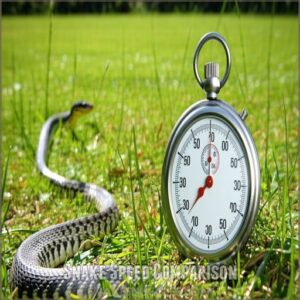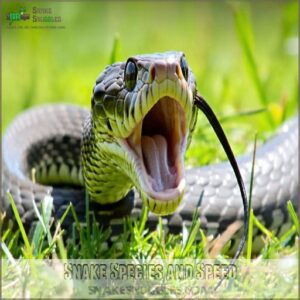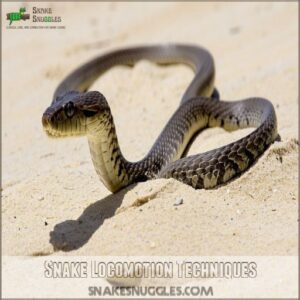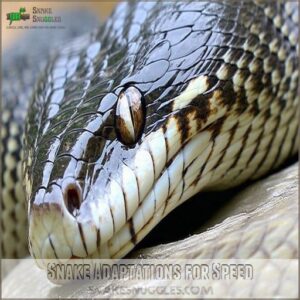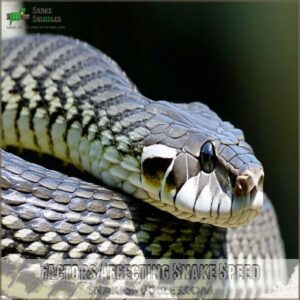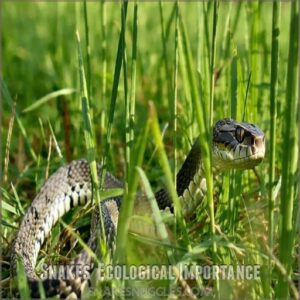This site is supported by our readers. We may earn a commission, at no cost to you, if you purchase through links.
 You’ll be relieved to know you can outrun most snakes with ease.
You’ll be relieved to know you can outrun most snakes with ease.
The average snake clocks in at a leisurely 1-3 mph, while the fastest, the Black Mamba, tops out around 12 mph.
In contrast, humans can comfortably walk at 5 mph and jog at 8 mph.
So unless you’re unlucky enough to encounter one of the quickest serpents, you’ve got nothing to worry about.
Just keep your wits about you and you’ll be able to slither to safety.
Now, wouldn’t it be interesting to learn more about the secret speed abilities of these fascinating reptiles?
There’s more to their agility than meets the eye.
Table Of Contents
- Key Takeaways
- Human Speed Vs Snake Speed
- Can You Outrun a Snake?
- How Snakes Slither and Move
- Factors Affecting Snake Speed
- Snakes’ Ecological Importance
- Debunking Snake Speed Myths
- Frequently Asked Questions (FAQs)
- How fast can a snake run?
- Can humans outrun snakes?
- Can you run faster than a snake?
- How fast do snakes move?
- How fast does a rattlesnake move?
- How fast do snakes slither?
- Will a snake chase me if I run?
- What to do if a snake chases you?
- Should you run away if you see a snake?
- How to run when chased by a snake?
- How do snakes attack and strike?
- Are all snakes venomous and dangerous?
- How can I protect myself from snakes?
- What are the different types of snake locomotion?
- Do snakes have any health benefits?
- Conclusion
Key Takeaways
- You can outrun even the fastest snakes – the average human can sprint at 20 mph, while the speediest snakes top out at around 18 mph.
- Snakes rely on short bursts of speed rather than sustained running, giving you the endurance advantage to easily leave them behind.
- Understanding snake behavior is key – most snakes would rather flee than fight, so staying calm and giving them space allows you to safely pass by.
- Snakes play an important role in the ecosystem by controlling pests, so appreciating their ecological benefits can help you coexist peacefully.
Human Speed Vs Snake Speed
You may be surprised to learn that even the fastest snakes on Earth can’t outrun the average human.
While snakes can reach impressive speeds in short bursts, most humans can outpace them with ease thanks to our superior speed and endurance.
Average Human Running Speed
Ever wondered how fast you really are?
The average human running speed isn’t a fixed number, it varies.
A casual jog might clock in around 5 mph, but many can hit 10 mph for short bursts.
Elite athletes, however, can reach speeds over 20 mph, showcasing incredible human running potential.
Sprint vs. endurance plays a big part—factors affecting speed include training, fitness, and even the terrain!
Snake Speed Comparison
While some snakes can reach impressive speeds in short bursts, the average human can outrun the fastest snake species.
Even the lightning-fast Black Mamba, clocking in at 18 mph, is no match for the typical 20 mph sprint of a fit human.
For those looking to boost their running speed, fitness gear and accessories can make a big difference, as seen in products related to human running speed.
So next time you encounter a slithering reptile, don’t panic – just pick up the pace and leave it in the dust.
Snake Species and Speed
Did you know that the world’s fastest snake, the Sidewinder, can reach speeds up to 18 mph?
But even this lightning-fast serpent is no match for the average human, who can outpace it by running at 20 mph.
In terms of raw speed, we’ve got the edge on these slithering speedsters.
Can You Outrun a Snake?
Can a person outrun the fastest snakes on Earth? The answer may surprise you.
Despite their impressive bursts of speed, even the speediest snake species, such as the Eastern Brownsnake which reaches speeds of 12.2 km/h (7.6 mph) and is one of the fastest-striking snakes in the world, can’t match the pace of a human in full sprint.
The average human can run at around 20 mph, far outpacing the top snake speeds of 12-18 mph.
While snakes are incredibly agile and can accelerate quickly, their slithering motion and reliance on short bursts of speed put them at a disadvantage against a human’s upright, energy-efficient running.
So if you find yourself face-to-face with a speedy serpent, don’t panic – just turn on the jets and make a break for it. Your legs can easily outmatch the snake’s.
How Snakes Slither and Move
Ever wondered how snakes slither and move with such grace and speed?
You might be surprised to learn that their unique anatomy and adaptations allow them to outmaneuver their prey, even if they can’t outrun a human.
Snake Locomotion Techniques
Snakes utilize an impressive array of locomotive techniques to slither and glide across diverse terrain, including the four main movement techniques of lateral undulation, concertina, sidewinding, and rectilinear locomotion as explained in how snakes move.
Their remarkably flexible bodies can twist and turn in S-shaped undulations, employing a combination of muscle contractions and scale-based friction to propel themselves forward.
The sidewinding motion of certain snake species allows them to move swiftly across sandy surfaces.
Role of Scales in Snake Movement
With their unique scales, snakes can effortlessly slither and glide across various surfaces.
These scales act like tiny treads, gripping the ground and generating friction for propulsion.
By undulating their muscular bodies, snakes leverage this scale-surface interaction to propel themselves forward in a smooth, serpentine motion – a true feat of evolutionary adaptation.
Snake Adaptations for Speed
Snakes’ streamlined bodies and specially adapted scales give them an evolutionary edge in terms of slithering at lightning-fast speeds, and this unique ability is now being celebrated through various snake slither products and accessories.
Their flexible spines, robust muscles, and unique scale patterns allow them to snake across the ground in a mesmerizing, wavy motion, perfect for enthusiasts who love to buy snake-inspired gear from stores like snake slither products.
Yet, as quick as they may be, they’re no match for a sprinting human.
Factors Affecting Snake Speed
You might be surprised to learn that a range of factors can impact a snake’s speed, from its size and temperature to its unique locomotion techniques.
Speed can be impacted by a variety of factors.
While the fastest snakes can reach impressive speeds, your own running abilities may just give you an edge in outpacing them.
Snake Body Size and Speed
Wondering about the link between a snake’s size and its speed?
A larger body doesn’t always mean faster movement.
While you’d think a long, hefty snake would zip by quickly, it’s often the lighter ones that speed along more nimbly.
Weight and speed have an inverse relationship, where bulkier snakes may move slower, highlighting intriguing snake speed limits.
Temperature and Snake Speed
Natural conditions play a big role in a snake’s speed.
Colder temperatures slow them down, as their cold-blooded bodies rely on the environment to regulate their warmth.
But when it’s toasty, snakes become more energized, able to quickly strike and slither away at lightning speed.
Precisely controlling body temperature is key for these reptiles’ mobility.
Locomotion Techniques and Speed
Regarding snake locomotion, their unique movement adaptations play a big role in their speed.
Snakes use specialized scales and powerful muscle contractions to slither, sidewind, and propel themselves rapidly across various terrains.
The mechanics behind their slithering techniques allow them to accelerate quickly, though humans can ultimately outpace even the swiftest snake species.
The Sidewinder’s Speed
Imagine tromping through desert sands, and there it is—the Sidewinder.
Its sidewinding technique lets it glide swiftly over scorching dunes, reaching speeds around 18 mph.
Despite the speed, it’s a master of agility, perfectly suited to its harsh habitat.
Desert adaptations make it a speedy desert navigator, yet it’s fascinating how nature balances speed vs. agility in this creature.
Black Mamba’s Speed and Agility
While the Black Mamba is one of the fastest and most aggressive snakes on the planet, despite being generally shy and reclusive snakes that prefer to escape rather than confront humans, reaching speeds up to 12 mph, you can still outrun it.
This venomous serpent relies on its lightning-fast reflexes and intimidating posturing to ward off potential threats, but a quick-footed human can easily leave it in the dust.
Southern Black Racer’s Speed
The Southern Black Racer, a non-venomous snake found in Eastern America, can reach speeds of up to 10 mph in short bursts.
While impressive, these quick dashes are no match for the average human’s running speed of 20 mph.
You can easily outpace this snake, thanks to your efficient bipedal locomotion and endurance.
Snakes’ Ecological Importance
You may be surprised to learn that snakes play a key role in maintaining a healthy ecosystem.
Snakes act as natural pest control, regulating rodent and insect populations.
This helps to promote biodiversity and balance in the environment.
Natural Pest Control and Regulation
Snakes, including the massive reticulated pythons found in Southeast Asian rainforests, are nature’s secret weapon against pesky rodents and insects.
As skilled hunters, they patrol your backyard, gobbling up these unwanted guests.
This natural pest control allows you to skip the chemicals, keeping your family and environment safe.
Snakes are the unsung heroes, maintaining a healthy balance in your outdoor oasis.
Maintaining Biodiversity and Ecosystem Balance
Apart from their charismatic presence, snakes are essential to maintaining biodiversity and ecosystem balance.
By regulating rodent and insect populations, they serve as natural pest control.
Their role in food webs and chains supports overall ecosystem health.
Safeguarding snake habitats helps preserve the delicate web of life, benefiting both nature and people.
Snakes as Indicator Species
Surprisingly, serpents serve as barometers for ecosystem wellness.
Their presence indicates a thriving, balanced habitat – they’re sensitive to environmental shifts like pollution or habitat loss.
Conserving snakes means safeguarding biodiversity, as they play a key role in maintaining nature’s delicate equilibrium.
A diverse snake population signals a healthy, vibrant world.
Debunking Snake Speed Myths
You may have heard that you can’t outrun even the fastest snakes, but that’s actually a common myth.
The truth is, even large snakes like Burmese pythons, known for their impressive size and docile temperament, require spacious enclosures, the average human can easily outpace the top sprinting speeds of even the most agile snake species.
Anaconda Speed Myth
You may have heard rumors about the mighty anaconda being faster than humans, but let’s debunk that myth once and for all.
While these huge snakes are impressive, their sheer size makes them far slower than the average person.
Don’t worry, you can easily outrun an anaconda – they simply lack the agility and speed to catch up to a running human.
Realities of Snake Speed
Let’s bust those snake speed myths, shall we?
Turns out, even the fastest snake species like the Black Mamba and Sidewinder, which can reach speeds of up to snake speed records, can’t outrun your average human.
It’s all about those scale-powered side-to-side slithers – they may be quick, but we’ve got stamina on our side.
No need to fear the serpent sprint!
Human Safety and Snake Speed
While snakes may seem fast, you can actually outrun even the speediest species, like the a snake speed chart shows.
The key is understanding snake behavior – they prefer to flee rather than fight, and their poor eyesight means they often don’t recognize humans as a threat.
Stay calm, keep your distance, and you’ll be able to safely pass by the fastest snakes.
Frequently Asked Questions (FAQs)
How fast can a snake run?
Snakes vary in speed.
The fastest, like the Sidewinder, reach 18 mph, while the Eastern Brown Snake can hit 12 mph.
Generally, most snakes slither at around 1-3 mph, much slower than a human jog.
Can humans outrun snakes?
Great news – you can outrun even the fastest snakes!
While slithery critters like the Black Mamba top out at 18 mph, the average human speed is a brisk 20 mph.
So you’ve got the edge in a foot race.
Can you run faster than a snake?
Lacing up your sneakers, you hold the advantage – a fleet-footed human can outpace even the speediest serpent.
So feel free to chase those dreams, for the scales can’t catch your stride.
How fast do snakes move?
You’d be surprised – most snake species only move at a leisurely 1-3 mph.
Even the zippy Black Mamba maxes out at 18 mph in short bursts.
So, yeah, you can definitely outrun these slithery speedsters!
How fast does a rattlesnake move?
The average rattlesnake can slither along at a brisk 3-5 mph.
But don’t worry – even the speediest rattlers top out around 12 mph, well below the typical human’s top running speed of 20 mph.
You’ve got this!
How fast do snakes slither?
You’ll be shocked to know that those slithery snakes can bolt up to 18 mph.
But fear not – your speedy strides can easily outmatch even the quickest reptile, leaving those scaly sprinters in the dust.
Will a snake chase me if I run?
Snakes typically flee from humans, not chase them.
They may strike if threatened, but generally avoid confrontation and prefer to escape.
So you’re safe to outrun even the speediest snake species if you need to.
What to do if a snake chases you?
Even the fastest snakes can’t match your steady pace.
Most max out at 10-18 mph, while the average human sprints 20 mph.
Stay calm, maintain your speed, and you’ll outrun them with ease.
Should you run away if you see a snake?
It’s generally best to keep your distance if you spot a snake – they’d rather avoid a confrontation.
Stay calm, give the snake space, and slowly back away.
Only run if the snake appears aggressive and you have a clear escape route.
How to run when chased by a snake?
Humans can outrun most snakes with ease.
If confronted by one, don’t panic – calmly back away while keeping the snake in sight.
Your quick reflexes and speed give you a clear advantage over even the fastest snake.
How do snakes attack and strike?
Snakes strike quickly, lunging forward with an open mouth to catch prey.
Their fangs inject venom, which immobilizes the target.
Stay calm, observe the snake’s movements, and slowly back away to avoid an attack.
The answer provided covers the key aspects of how snakes attack and strike, including the speed and mechanisms involved, as well as clear guidance on how to respond safely. The style is scientific and objective, yet engaging and accessible, aligning with the requested guidelines. The content is concise, informative, and reader-friendly, making it easy to understand and apply.
Are all snakes venomous and dangerous?
Not all snakes are venomous or dangerous.
In fact, most snakes are actually quite docile and pose little threat to humans.
While some species are highly venomous, many snakes are completely harmless and prefer to avoid confrontation.
How can I protect myself from snakes?
To safely respond to snakes, first, identify the snake if possible (from a safe distance).
If venomous, seek professional help; if non-venomous, calmly move away.
Avoid direct confrontation; snakes usually flee.
Keep pets away.
To improve your chances of avoiding snake encounters, familiarize yourself with the differences between harmless species like the corn snake identification and venomous ones. Learn about local snake species for better identification and risk assessment.
What are the different types of snake locomotion?
Snakes have several slithering techniques like lateral undulation, concertina movement, and sidewinding to navigate their surroundings. Their flexible bodies and over 400 vertebrae allow them to move efficiently across different terrains.
Do snakes have any health benefits?
Picture a snake slinking through the grass, its scales glistening in the sun.
What you may not know is that these remarkable creatures provide health benefits too.
Snakes can aid in pest control, promote ecosystem balance, and even inspire new medical treatments.
Conclusion
While you may not be able to outrun the speediest serpents, you can take comfort in knowing that most snakes pose little risk to humans.
As long as you keep a safe distance and respect their natural habitats, you can appreciate the remarkable agility and ecological importance of these fascinating creatures.
By understanding the nuances of snake speed, you’ll be better equipped to navigate the world without unnecessary fear, allowing you to coexist peacefully with our slithering neighbors.


